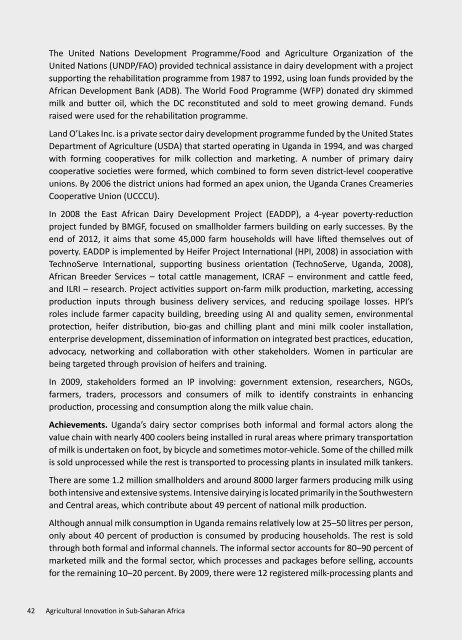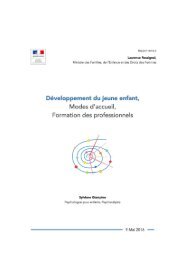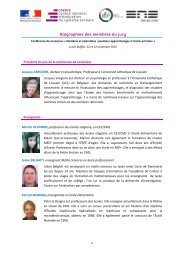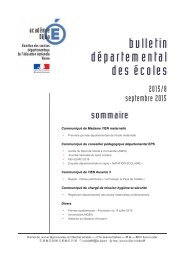agrl_innovations_in_ssa.pdf?utm_content=buffercb41d&utm_medium=social&utm_source=twitter
agrl_innovations_in_ssa.pdf?utm_content=buffercb41d&utm_medium=social&utm_source=twitter
agrl_innovations_in_ssa.pdf?utm_content=buffercb41d&utm_medium=social&utm_source=twitter
You also want an ePaper? Increase the reach of your titles
YUMPU automatically turns print PDFs into web optimized ePapers that Google loves.
The United Nations Development Programme/Food and Agriculture Organization of the<br />
United Nations (UNDP/FAO) provided technical assistance <strong>in</strong> dairy development with a project<br />
support<strong>in</strong>g the rehabilitation programme from 1987 to 1992, us<strong>in</strong>g loan funds provided by the<br />
African Development Bank (ADB). The World Food Programme (WFP) donated dry skimmed<br />
milk and butter oil, which the DC reconstituted and sold to meet grow<strong>in</strong>g demand. Funds<br />
raised were used for the rehabilitation programme.<br />
Land O’Lakes Inc. is a private sector dairy development programme funded by the United States<br />
Department of Agriculture (USDA) that started operat<strong>in</strong>g <strong>in</strong> Uganda <strong>in</strong> 1994, and was charged<br />
with form<strong>in</strong>g cooperatives for milk collection and market<strong>in</strong>g. A number of primary dairy<br />
cooperative societies were formed, which comb<strong>in</strong>ed to form seven district-level cooperative<br />
unions. By 2006 the district unions had formed an apex union, the Uganda Cranes Creameries<br />
Cooperative Union (UCCCU).<br />
In 2008 the East African Dairy Development Project (EADDP), a 4-year poverty-reduction<br />
project funded by BMGF, focused on smallholder farmers build<strong>in</strong>g on early successes. By the<br />
end of 2012, it aims that some 45,000 farm households will have lifted themselves out of<br />
poverty. EADDP is implemented by Heifer Project International (HPI, 2008) <strong>in</strong> association with<br />
TechnoServe International, support<strong>in</strong>g bus<strong>in</strong>ess orientation (TechnoServe, Uganda, 2008),<br />
African Breeder Services – total cattle management, ICRAF – environment and cattle feed,<br />
and ILRI – research. Project activities support on-farm milk production, market<strong>in</strong>g, access<strong>in</strong>g<br />
production <strong>in</strong>puts through bus<strong>in</strong>ess delivery services, and reduc<strong>in</strong>g spoilage losses. HPI’s<br />
roles <strong>in</strong>clude farmer capacity build<strong>in</strong>g, breed<strong>in</strong>g us<strong>in</strong>g AI and quality semen, environmental<br />
protection, heifer distribution, bio-gas and chill<strong>in</strong>g plant and m<strong>in</strong>i milk cooler <strong>in</strong>stallation,<br />
enterprise development, dissem<strong>in</strong>ation of <strong>in</strong>formation on <strong>in</strong>tegrated best practices, education,<br />
advocacy, network<strong>in</strong>g and collaboration with other stakeholders. Women <strong>in</strong> particular are<br />
be<strong>in</strong>g targeted through provision of heifers and tra<strong>in</strong><strong>in</strong>g.<br />
In 2009, stakeholders formed an IP <strong>in</strong>volv<strong>in</strong>g: government extension, researchers, NGOs,<br />
farmers, traders, processors and consumers of milk to identify constra<strong>in</strong>ts <strong>in</strong> enhanc<strong>in</strong>g<br />
production, process<strong>in</strong>g and consumption along the milk value cha<strong>in</strong>.<br />
Achievements. Uganda’s dairy sector comprises both <strong>in</strong>formal and formal actors along the<br />
value cha<strong>in</strong> with nearly 400 coolers be<strong>in</strong>g <strong>in</strong>stalled <strong>in</strong> rural areas where primary transportation<br />
of milk is undertaken on foot, by bicycle and sometimes motor-vehicle. Some of the chilled milk<br />
is sold unprocessed while the rest is transported to process<strong>in</strong>g plants <strong>in</strong> <strong>in</strong>sulated milk tankers.<br />
There are some 1.2 million smallholders and around 8000 larger farmers produc<strong>in</strong>g milk us<strong>in</strong>g<br />
both <strong>in</strong>tensive and extensive systems. Intensive dairy<strong>in</strong>g is located primarily <strong>in</strong> the Southwestern<br />
and Central areas, which contribute about 49 percent of national milk production.<br />
Although annual milk consumption <strong>in</strong> Uganda rema<strong>in</strong>s relatively low at 25–50 litres per person,<br />
only about 40 percent of production is consumed by produc<strong>in</strong>g households. The rest is sold<br />
through both formal and <strong>in</strong>formal channels. The <strong>in</strong>formal sector accounts for 80–90 percent of<br />
marketed milk and the formal sector, which processes and packages before sell<strong>in</strong>g, accounts<br />
for the rema<strong>in</strong><strong>in</strong>g 10–20 percent. By 2009, there were 12 registered milk-process<strong>in</strong>g plants and<br />
42 Agricultural Innovation <strong>in</strong> Sub-Saharan Africa






